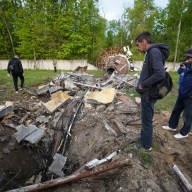Ten and 13 are the unlucky numbers for LIRR riders.
If snowfall reaches 10 to 13 inches, the LIRR may shut down parts of or entire lines as train switches and signals freeze and heavy winds blow snow onto the tracks. The preventative move would keep trains from getting stuck and allow crews to clear tracks quicker.
“Ten to 13 inches is where the bells and whistles start going off,” said LIRR spokesperson Sal Arena.
And for those who transfer to subways in the city, take note: For years, the highest alert system the MTA used in snow was Level 4, but the Dec. 26 blizzard forced the MTA to rethink their emergency preparedness. Yesterday, the agency unveiled Level 5, a drastic measure that would entail service shutdowns on subway lines.
But not everyone agreed the MTA should be so quick to close entire lines.
“Limited service is a last resort,” said MTA Board member Ira Greenberg. “When people can’t get to work, it’s a severe impact on employers.”
Today’s commute
In anticipation of the snowfall overnight, the LIRR canceled 14 of the
143 westbound trains into Manhattan this morning. Buses replaced train
service east of Speonk on the Montauk branch and east of Ronkonkoma on
the Main Line to Greenport.
Do’s and Don’ts
DO …
» A few warm-up exercises before shoveling snow, and take frequent breaks.
» Lift with your legs, never with your back.
» Drive on major routes. They are cleared and treated first.
» If you must drive, dress as if you were going to be stranded. It can get very cold in a car on the side of a road waiting for help. Pack extra blankets.
» Prepare for power outages. Make sure you have candles, emergency food supplies and a battery-operated radio.
DON’T …
» Shovel snow if you have a history of heart trouble or difficulty breathing.
» Travel in a blizzard. Look for a hotel or stay off the road until conditions are safe again.
» Use cruise control in slippery or icy conditions, you won’t have total control over your car.
» Drive in four-wheel-drive. It will get you going faster, but it does not provide an advantage in stopping.
» Change lanes while driving. Changing lanes over built-up snow may cause you to lose control of your vehicle.
















